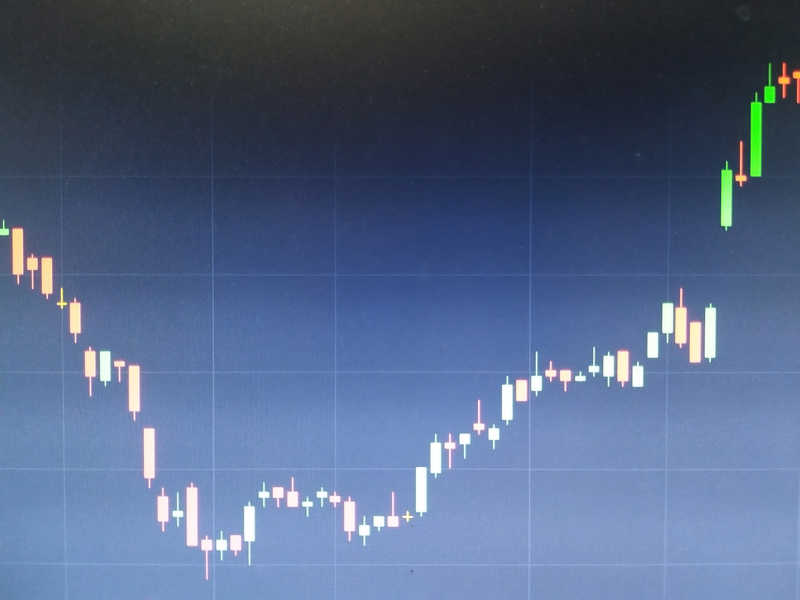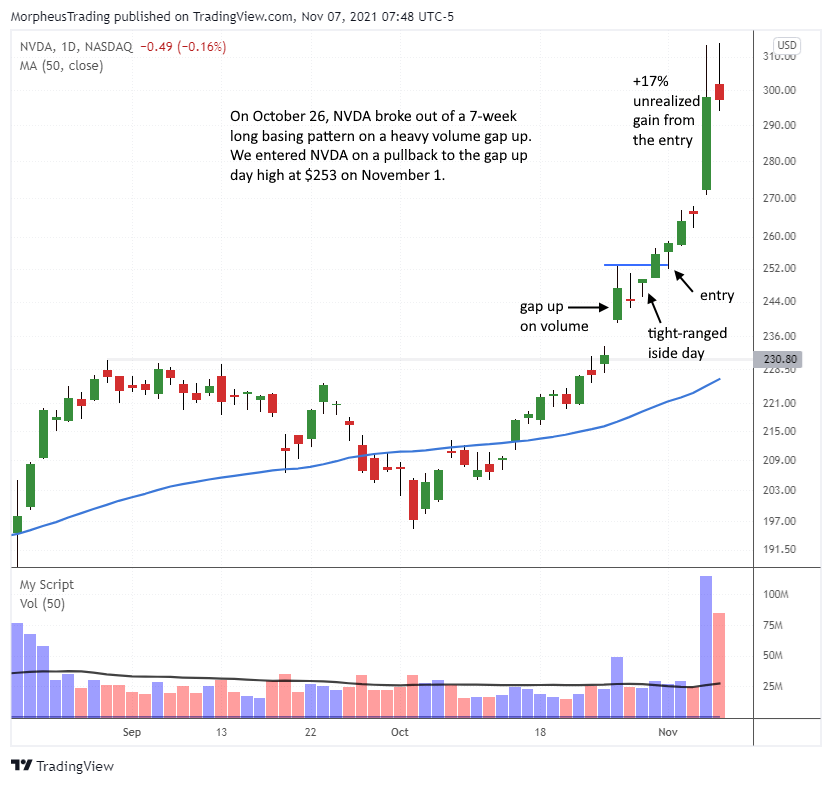Some of our biggest winning stock trades are buy entries of the explosive “breakaway gap” chart pattern. Here, we show you 3 simple entry points to profit from trading breakaway gaps.
A breakaway gap occurs when the opening price of a stock “gaps” well above technical price resistance (gap up) or below support (gap down).
When the overall market is in a “buy” signal, these gaps can lead to explosive moves over several months.
Breakaway gaps often lead a stock’s price to double in just 8 to 12 weeks (depending on a stock’s volatility)–but only with a clear understanding of the specific buy signals and proper time to enter.
Continue reading to discover exactly when to buy a breakaway gap, and the ideal entry points for the most positive risk-reward ratio.
How To Find A Breakaway Gap Pattern
A breakaway gap is one of our favorite patterns because it often occurs early in the start of a trend, and shows conviction in the direction of the new trend.
A breakaway gap up can be an extremely bullish signal IF the gap emerges from a valid basing pattern that is confirmed by bullish price and volume action.
Below are five specific signals to help you properly identify a breakaway gap trade setup.
5 Signals To Find The Best Breakaway Gap Ups
- A breakaway gap should be preceded by a valid basing pattern at least four to five weeks in length. The longer the price consolidation, the more powerful the breakaway gap may be.
- Volume on the gap day should be at least 100 to 200% greater than average (based on 50-day average volume). With small and mid-cap stocks, volume may even surge to five to ten times greater than average.
- A breakaway gap up should open at least 4-5% above the prior day’s close–some of the best gaps are 5-10% higher or more. However, an opening gap of more than 30% is a bit too much and could lead to a few months of chop, rather than immediate upside follow-through. Swing traders don’t need to buy on the gap day, so we have the luxury of waiting to see price and volume action before entering.
- The opening price of the gap day should be above the high of the base of consolidation (resistance). However, an opening gap slightly below the high of the base may still be bought IF the move is confirmed by price and volume.
- The closing price of the gap day should be above the opening price, or at least near the open. We generally avoid breakaway gaps where the closing price is well below the open or the gap is filled.
Not All Breakaway Gaps are Buyable
Buying a proper breakaway gap at the right time can lead to massive gains–but not all breakaway gaps are buyable.
For a breakaway gap to be bought, it must first meet two criteria:
- As mentioned above, the base that preceded the gap up should be at least four to five weeks long. If a base is too short, there may not be enough pent-up buying pressure from the consolidation to enable the breakaway gap to follow through.
- Avoid buying a breakaway gap if the stock had already gapped up multiple times within the past few months. A proper breakaway gap should jump out as the first, clear gap above a solid base of consolidation of at least four to five weeks.
3 Proper Entry Points for Buying Breakaway Gaps
Once we have established that a gap up is buyable, there are three potential buy points to monitor.
- Buying near the open on the day of the gap.
This is a legit buy entry for traders who are able to participate in the market during trading hours.
With the Morpheus Trading strategy, we typically buy a half position on the opening strength, by waiting for a move above the 1 or 5-minute opening high.
Alternatively, we buy the opening gap up on weakness if the stock shows signs of strength after 15 to 30 minutes of opening weakness.
While buying the opening gap can be ideal, don’t feel left out if you are not able to trade during market hours.
Next, we will walk through two alternate buy points for part-time traders who trade stocks as a side hustle–just like most of our members.
2. Rally above the high of the gap-up day (when volume confirms)
If you are unable to buy the day of the gap-up, a move above the high of the gap-up day becomes a secondary buy point–but only if the breakaway gap was confirmed by higher volume.
Volume on the day of the breakaway gap should be 100 to 200% above its 50-day average volume level.
For newer stocks, the volume surge can be much higher.
For well-known, highly liquid stocks (like $NVDA), we are fine with buying a breakaway gap even if the volume increase is slightly below 100%.
When volume confirms, the high of the gap-up day becomes the secondary buy point.
3. Pullback to the high of the gap-up day
If you miss the first two entries above, the third potential entry point is a pullback to the high of the gap-up day.
This third method is how we recently entered $NVDA in The Wagner Daily report:
$NVDA broke out from is base on volume that was 85% above average.
Ideally, we like to see a 100-200% volume spike, but 85% above average is fine for an established, liquid stock like Nvidia.
Note that the price chopped around for two days following the gap up day, with the second day of chop forming a tight-ranged inside day on lighter volume (bullish action).
On October 29, $NVDA cleared the gap-up day high on a pick-up in volume, which was a clear buy signal (#2 method).
We missed the $NVDA buy entry that day, but immediately alerted members of our nightly stock trading report of a potential pullback entry at $253.
Our buy limit order triggered the following day, as $NVDA found support and reversed higher.
Nvidia did not look back after our entry, as the stock gained +24% in just four days before stalling just above $300.
We are still holding $NVDA with an unrealized gain of +17%, and will continue to trail a stop higher to maximize profits as the trend continues higher.
As always, we will alert Wagner Daily subscribers of further changes to the exit strategy in the portfolio section of the nightly report.
Top Tips For Trading The Breakaway Gap
- Pay attention to where the stock closes on the gap-up day. Strong stocks that follow through to the upside often find support at the closing price of the original gap up. It is a bullish sign if they do, as was the case with $NVIDA.
- A breakaway gap up stock should find support at its first test of the 10-day moving average if momentum is strong. If the 10-day moving average does not hold, then we would look for the 20-day exponential moving average to provide support after a few weeks of chop.
- We generally try to limit breakaway gap trading to stocks that also have strong earnings and revenue growth. This increases the odds of institutional accumulation powering the stock price higher.
Conclusion
Breakaway gap ups should always be monitored by swing and position traders for low-risk entry points because they can be quite explosive.
Use the five signals above as a checklist to confirm the validity of a breakaway gap chart pattern, then patiently wait for a low-risk entry point on a pullback to near-term support.
Always use protective stops and trail them higher to minimize risk and maximize profit as the trade moves in your favor.
Subscribe now to The Wagner Daily newsletter to be alerted to the next hot breakaway gap trade setup on our radar.
Do you also trade crypto? Check out our new Morpheus Crypto service for the hottest swing trade picks in leading cryptocurrencies.



